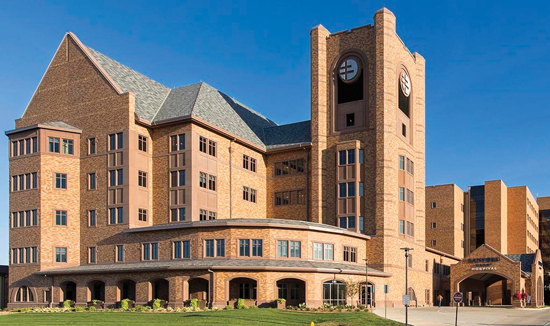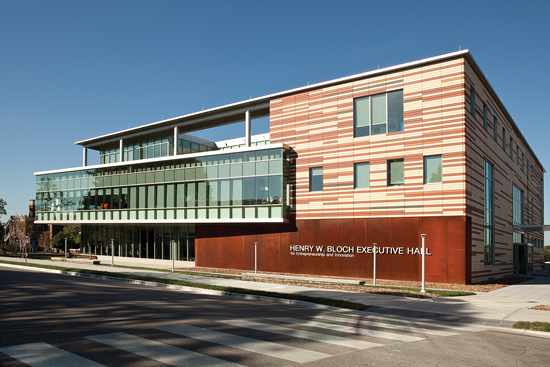High-Performance Aesthetics in Precast Concrete
Embedding Natural Materials into Precast Concrete
In addition to the full range of color and texture options, precast concrete can also be embedded, or veneered with, natural materials, such as clay thin brick, terra cotta or granite.
Embedded Thin Brick
When thin brick is used, clay or concrete bricks with a minimal thickness (typically around 1/2- to 5/8-inch thick) are set into forms and cast into the precast concrete. Embedded brick precast comes in almost all the shapes, colors, and sizes as field-laid brick and can be formed into any pattern, such as running bond or stack bond. Traditional brick wall details also can be included, such as soldier course and headers.
Embedding thin brick provides all the scaling and beauty of natural materials but with the speed, durability, and other high-performance benefits of precast.

Photo courtesy of Gage Brothers
The Sanford Heart Hospital uses precast concrete panels embedded with thin brick to create a very detailed, yet traditional facade. Precast panels include arches and many unique pieces along with integration of exposed precast concrete sills, trim, and banding.

Photo courtesy of Jacia Phillips Photography.
This high-performance, precast concrete enclosure at the Bloch School, University of Missouri, uses embedded terra cotta on precast panels with 4” of continuous insulation (edge-to-edge) to provide a very efficient high-performance enclosure system.
Veneered Materials: Stone, Granite, Glass
Natural stone, veneer-faced precast concrete has become widely used in building construction because of its strength, durability, aesthetic effect, availability, and inherent low maintenance costs. Many natural materials can be veneered onto precast, like limestone or granite. However, unlike clay products, these materials usually are veneered via some form of pin connectors and use a bond breaker. Typically, these also use larger pieces of stone.
Benefits of veneers are numerous. Veneering natural stone into precast transfers the loads to the precast bearing points, making it easier to handle the loading. It allows for multi-plane, curves, or difficult shapes to be constructed easily. Using veneers also means capturing timesaving; several pieces are erected at one time, since they are integrated into larger precast panels. On-site, no storage or staging is required, and there is no need for scaffolds. Instead of requiring several subcontractors to set stone, you have one precaster, who also performs the erection. Furthermore, veneers are durable; this strategy reduces the number of joints and connections that need to be maintained.
Using veneers also reduces the overall amount of natural material needed, meaning less weight, and less fuel and cost to transport. A comparative analysis was performed on a dormitory project in Florida comparing thin brick to field-laid brick. Over a 100,000-square-foot area, using thin brick saved 1,150 tons of raw materials, 12,600 gallons of diesel fuel, and almost $70,000 from the cost.
For quality assurance when working with natural materials, color control or blending for uniformity should take place at the stone fabricator’s plant because ranges of color and shade, finishes, and markings such as veining, seams, and inclusions are easily seen during the finishing stages. Acceptable stone color should be judged for an entire building elevation rather than for individual panels. The responsibility for stone coordination should be written into the specifications so it can be priced. The owner, architect, and stone purchaser should visit the stone fabricator’s plant to view the stone veneer, and establish criteria and methods for color-range blending on the project.









